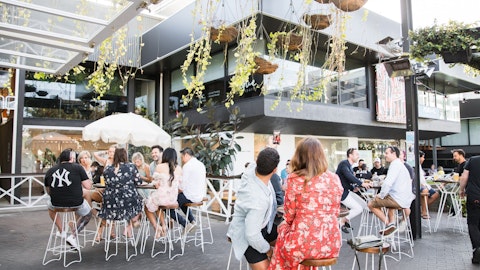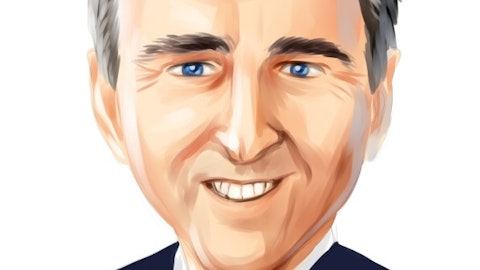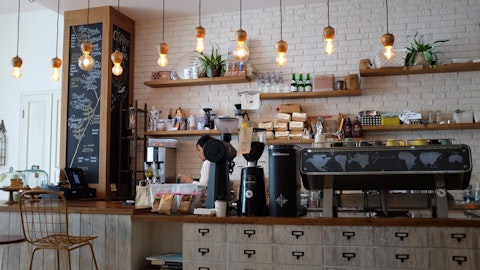Vance Chang: So, based on the current trends, we’re expecting sort of mid-single digit inflation for our two brands a little bit higher for IHOP, a little bit lower for Applebee’s, but roughly in that range, on top of sort of the 18% 20% inflation that we experienced in 2022. Now, the disclaimer is that, macro pressures from Ukraine, China, opening up the Fed rate hikes, et cetera. But they’re all playing to us. So it’s hard to be definitive, what we’re seeing is, is a softening of the inflation for 2023.
Todd Brooks: And just a follow up to that, I guess, where do franchisees seem to feel as far as the value that both brands are still delivering with the price increases have been taken? And do you sense any, maybe catch up on incremental pricing? As you guys have been pricing behind the inflation that both brands have experienced? Thanks.
John Peyton: Yes, Todd, its John, I’ll take that. And I’ll ask Tony and Jay to comment if they want to if they want to add on but. As you said, about on average, our franchisee have raised prices, about half of the cost of inflation of cost of goods into the restaurants. And we like where they are, because I think they’re aligned with us strategically about the being a value oriented brand. They understand where their guests are right now, and the effect of the economy on them. And I think they’ve taken you know, prudent and responsible pricing that is balancing both their own margins as well as, remaining attainable to our guests. When you look at our performance of the quarter in our comp sales, we think we hit that sweet spot of the franchisees protecting as much margin as they can, but also not driving their customers away with prices that are too steep. Tony, do you want to add anything?
Tony Moralejo: Yes, thanks, John. Pricing is just part of the value equation. And the way our franchisees approach it, the way the brand approaches that is value is more important than ever, because of inflation and rising consumer credit card debt, lower savings, et cetera. Our guests are prioritizing how they’re spending money and determining at the end of the day, what’s most important to them, offering a reasonable price. That’s table stakes when it comes to value for our guests. To win on value, we believe you have to deliver more than just an attractive price, you need to deliver what we call a value experience, which triggers a feel good element with your guests. This can come from indulgence or sharing a meal with family and close friends. And so for those reasons Applebee’s and the Applebee’s franchisees were focused on elevating the total guest experience in addition to offering compelling value offerings.
Jay D. Johns: Yes, this Jay. From an IHOP standpoint, I think the franchisees, as John said, are being very prudent about this. But we some people refer to it as a barbell strategy. We have places where guests can get value at our restaurant, even though they’ve needed to take some price. They’ve been very smart and continue to support value initiatives. We have everyday value with our high Hoppy Hour program, we do limited time offers, like the BOGO on our crates we’re doing right now or the Rudy 2d We did for $6 in the first year, we can even offer exclusive value now because we’re a loyalty program we can send offers directly to people that are in our program, that unique value just for them and a reason for them to sign up for the program.
So I think they’re doing a good job of balancing that and as prices come down, I’m sure their costs come down. I’m sure that their prices to their guests are going to moderate as well and go back to more reasonable levels. And there may be a catch up opportunity at some point but they’re not going to they’re not going to do anything to hurt the guest experience and run off their guests because of it.
Operator: Next question comes from the line of Nick Setyan with Wedbush, your line is open.
Nick Setyan: Thank you, just given the outside performance poured a day in Q1, would it be possible for you to maybe make an exception just one time and just talk about your current correlating Q1 at least in general terms?
John Peyton: Nice try, Nick, I’ll see what I can I can see what I can do, its John, we’re not we’re not going to give specific numbers about Q1. But what I can tell you is that the trend and the pace and the momentum that we see that we see ending last year is certainly baked into our, our guidance for this year.?
Nick Setyan: Got it. One of the big worry that there is that we’re going to see incremental competition, particularly in the Applebee’s peer set with one of your biggest competitors being more on television and advertising some aggressive price points on an ongoing basis. I guess, what’s your response to that? How are you positioned in terms of your marketing cadence, how you feel about sort of incremental competition as this year progresses?
Jay D. Johns: Sure, I’ll talk about that broadly. And then ask Tony to comment. A little bit more specifically for Applebee’s. As a former, CMO at Starwood Hotels for a long time, and I like the position that Applebee’s is in, Applebee’s is, is in a position of strength right now. It is in its fourth or fifth year of an extraordinarily successful and consistent marketing campaign, particularly television where I think it actually does the best TV in the category. And so, heading into ’23, which again, is an uncertain year in terms of consumer behaviour. I’d much rather be where Applebee’s is, the brand that has a clear position, has off the charts awareness scores from its, and has a consistent winning message on television Then having to rather be there than spending a lot of money to create a new point of view about a brand from scratch. Tony, you want to add on to that?
Tony Moralejo: Yes. Thanks, John. And, well said, Look, I’ll start, Nick, great question. I’ll start by saying, we’re very confident with the Applebee’s brand position. We’re very confident with our value proposition. And we’re very confident with the marketing calendar sits for the entire year. More importantly, the entire Applebee’s system is nimble and agile. And we’re prepared to pivot if necessary, we’ll make changes should any competitor or market force want such action. But while others are trying to figure out the new campaigns, we’ve got a five-year track record. We’ve got a proven sustainable playbook. And it’s producing winning results. So we’re going to remain focused on our playbook. We’re going to continue to use our strategy to drive business results. And we’re going to continue to connect with our guests through great marketing and restaurant experience.
Q €“ Nick Setyan: Thank you very much.
Operator: And our next question comes from Brian Vaccaro with Raymond James. Your line is now open.
Brian Vaccaro: Thanks and Good morning. Just piggybacking on Nick’s question on Applebee’s and, Tony, you mentioned the strength across various brand attributes. I was hoping you could hone in maybe a little more specifically on brand awareness. Is there any quantification you can provide on how much Applebee’s awareness metrics have increased versus category peers? Or perhaps to what degree you think Applebee’s trends over the last couple of years as a pandemic have benefited from that awareness?
Tony Moralejo: Thanks, Brian. I don’t have specific metrics results to share with you today. But let me say this when it comes to indicators, what gives us confidence it first starts with sales. And we’ve had a nice three year run with sales. And in addition to stringing together three strong years, we’ve had, as part of that eight consecutive quarters strong sales performance. But from a brand attribute perspective, specifically, we lead the casual dining category in metrics such as affordability, which is incredibly important in this environment, unaided brand awareness, unaided ad awareness, aided to go awareness and delivery awareness. And also, I’ll add that our advertising under the leadership of Joe , our Chief Marketing Officer, it continues to deliver award winning campaigns that really resonate with our guests, and will continue to you’ll continue to see amazing value added partnerships throughout the year that I referenced examples of in my opening comments.
So all of these factors are very, very encouraging and our brand health today remains robust.
Brian Vaccaro: Okay, and then I also wanted to just circle back on franchisee profitability. Could you provide any more color just kind of exiting 2022? Just ballpark where average store level EBITDA margins might be for each brand? And just how you expect that to trend through 2023? I think Vance had said mid-single digit food inflation, but how about — what are you what are the expectations on wage inflation and any specific savings initiatives that are worth highlighting?
John Peyton: So a couple of questions to peel back here. So first, overall franchisee profitability without getting into the specifics of our franchisees P&L, let me say that our portfolio is very strong overall, thanks in part to finishing 2022 with all time high annual average unit restaurant volume of 2.8 million per restaurant, as our average unit volumes improve, the health of the system continues to get better and better. With respect to the cost side of the equation, franchisee margins, especially food costs, they were impacted, but they remain healthy. And the good news here is that we’re now seeing some moderation anticipate more relief later this year. In terms of specifically of food costs for this past year, we saw our basket increased by 18%. As Vance mentioned,
Vance Chang: The food cost for Applebee’s system. It’s roughly 25% of sales. So the math there is, you apply the inflation percent to our food causes sort of the P&L impact, right, but you asked about specific cost saving initiatives. So each one of our brands, we have cross functional teams between the purchasing Co Op operations, the franchisees to come up with cost saving ideas to lower production costs, reduce waste, or usage, or improve restaurant labor, while just obviously not impact negatively impacting the guests experience. So, some of these ideas include like packaging, distribution, shrink reduction initiatives, server tablets to help save labor, energy fixing equipment, reviewing product specific indications, all these things are, are in conjunction to help offset sort of inflation that the franchisees are saying.
Brian Vaccaro: Okay, thank you for that. And then and then just one last one, if I could on the development guidance, how many openings and closures does your net unit guidance embed at each brand? And then how many Fuzzy’s? Do you expect to open in 2023? Thank you.
John Peyton: We haven’t guided on gross versus closure. Wheat we guided was the net number. And Fuzzy is also you know, I think, right now, it’s — think of it like, like our international businesses, this is not significant enough just yet on a consolidated level for us to break it out. So we’re not providing separate guidance, but obviously, we will report accordingly, as the system grows over time.
Brian Vaccaro: All right, I’ll pass it along. Thanks very much.





